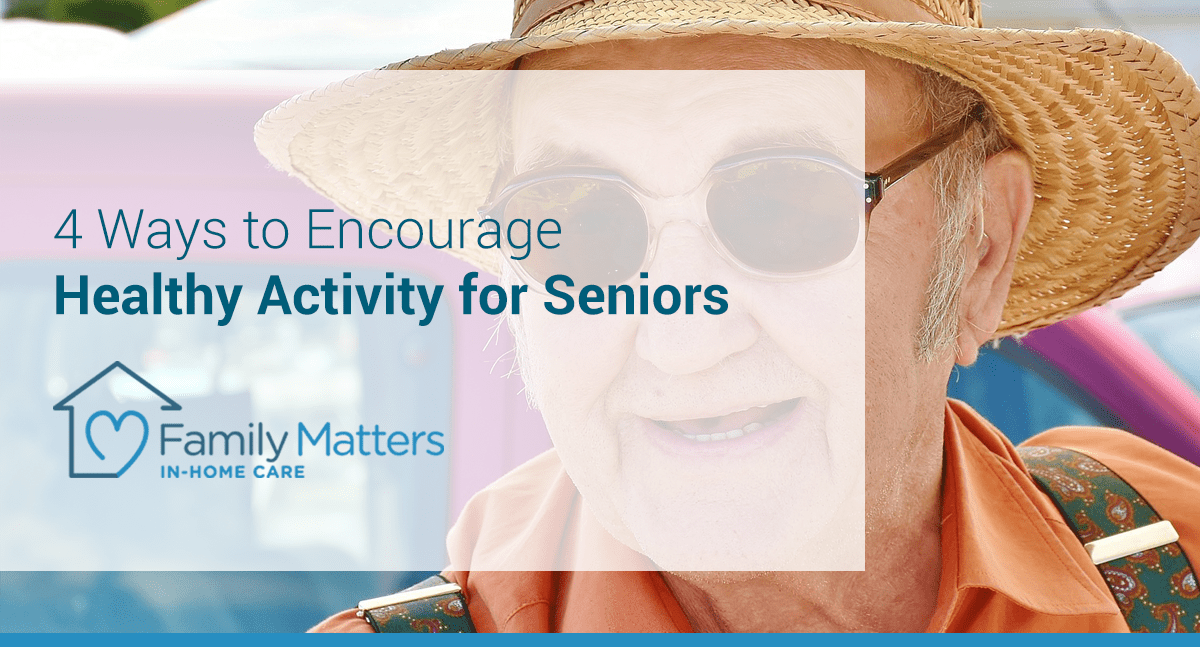
4 Ways to Encourage Healthy Activity for Seniors
Every year, National Senior Health and Fitness Day is celebrated on the last Wednesday in May, a day when organizations around the country encourage seniors to adopt healthy habits. This year marks the 25th anniversary of the program and it’s estimated that more than 120,000 seniors across the country will participate in healthy events to celebrate. The goal of National Senior Health and Fitness Day is to promote the importance of physical activity for wellness and longevity. We want to help. Here are four ways to encourage healthy activity for seniors.
1. Encourage your loved one to exercise with you.
Walking is great exercise and it’s free. Choose a route with fairly even walking surfaces, put on sturdy, non-slip walking shoes and get outside. Walking has many physical benefits; it lubricates the joints, increases oxygen to the heart, lungs and brain, and strengthens muscles and ligaments. It can also strengthen legs and improve core strength which in turn can help to prevent falls. Whether your loved one has full or limited mobility, walking is beneficial.
If your loved one is in a wheelchair, encourage him or her to get outside with you and move the wheelchair with his or her legs. It will promote circulation and help to strengthen the legs.
2. Find community fun
Many communities have activities for seniors, either at a senior center, a YW/YMCA, a church or civic organization. One of the most popular games they hold for seniors is called Balloon Volleyball. It’s especially beneficial for those in wheelchairs. Here’s how you can set up a balloon volleyball game for your senior group, or your family:
- Organize players in two lines facing one another.
- Begin by batting a balloon up and down the row.
That’s all there is to it. As seniors move their arms to bat the ball it will increase oxygen flow while moving the muscles and ligaments. Their breathing and brain activity will increase and it will encourage hand-eye coordination. It’s also fun and will improve mood through laughter and interaction with others.
3. Combine movement with things seniors love
Some seniors may resist going for a walk. Not everyone relishes the thought of exercise. Depression, anxiety, and fatigue may prevent your loved one from considering a walk or game as a fun activity. However, if you connect your loved one with a favorite hobby or pastime, you may be able to get him or her moving physically. For example:
- Go to an art museum to walk through one or two rooms or view a special exhibit.
- Go to a public garden to see the latest flowers in bloom.
- Go to a mall to have lunch at a restaurant or the food court. Make sure a bit of walking is required to get to your destination.
- Go downtown to window shop and then have coffee or tea.
4. Get the grandchildren involved
When all else fails call in the troops! Grandchildren can often encourage grandparents to do things that parents cannot. If the children are old enough, explain to them in advance why you need their help to get their grandparent moving. Empower them to think of things on their own that could get their grandparent to exercise (safely) their arms and legs. (Parents may want to supervise to ensure the senior gets some exercise but isn’t thoroughly exhausted.)
Activities can include:
- The senior sits in a chair and tosses a beach ball or large rubber ball back and forth with the child.
- The child and senior walk up and down the driveway together.
- The child and senior walk around the yard as the child picks flowers.
- Play a version of the old game “Simon Says”. For example, the child does jumping jacks and the grandparent must mimic their arm movements.
Exercise improves wellness
There are many benefits of exercise for seniors. Physical activity improves mental, physical and emotional well-being. It can help to prevent heart disease and stroke, manage diabetes and feed oxygen to the brain that in turn may help to delay dementia.
Other benefits of exercise include:
- Movement, like walking, strengthens bones, muscles, ligaments and tendons and helps to lower the risk of osteoporosis
- It improves overall body strength
- It improves core and leg strength that can help to prevent falls
- Increased oxygen to the brain can improve decision making
- Exercise can increase the brain’s production of serotonin that helps to regulate mood and may naturally fight depression
When it comes to the responsibilities you carry for your senior loved one, exercise may be the last thing on the list. However, if your loved one faces wellness, mood or cognitive challenges, a bit of daily exercise may actually help to address those issues and prevent them from worsening.
If you or your family member is considering in-home care as part of a plan to age in place, contact Family Matters In-Home Care today for a free consultation. Our team is dedicated to supporting your family and helping older adults enjoy life in the comfort of their own home for as long as possible.
Some of the services offered by Family Matter In-Home Care include: Alzheimer’s & Dementia Care, Bed & Wheelchair Transfer Assistance, Companionship, Housekeeping & Meal Preparation, Personal Care, Recovery Care, and Transportation.
